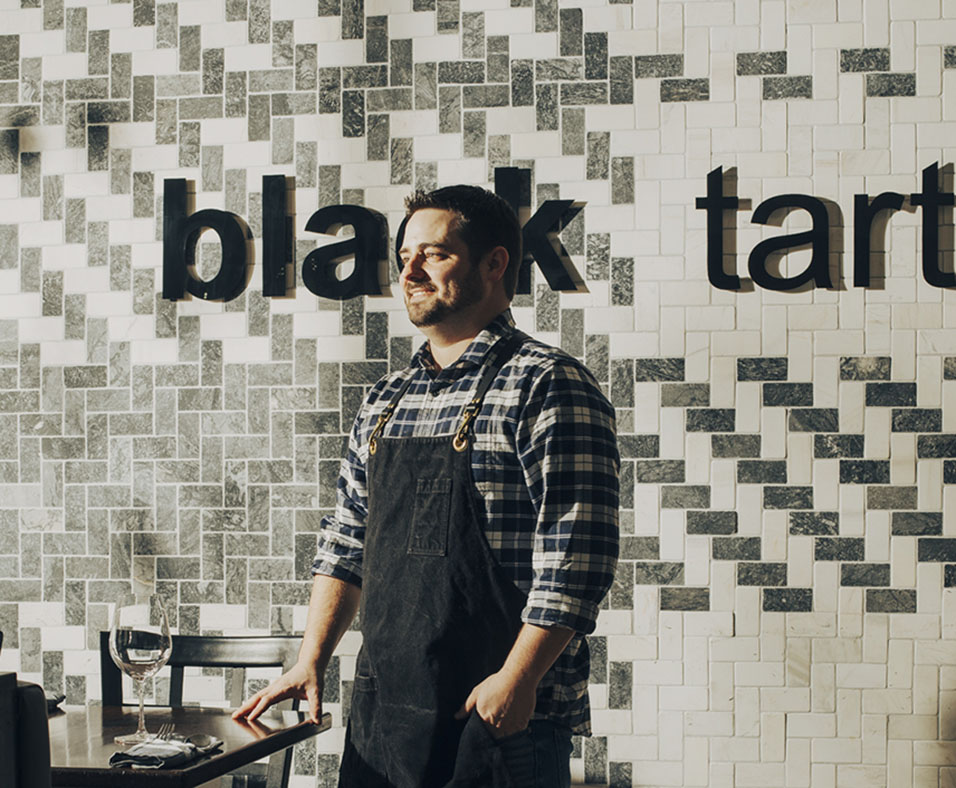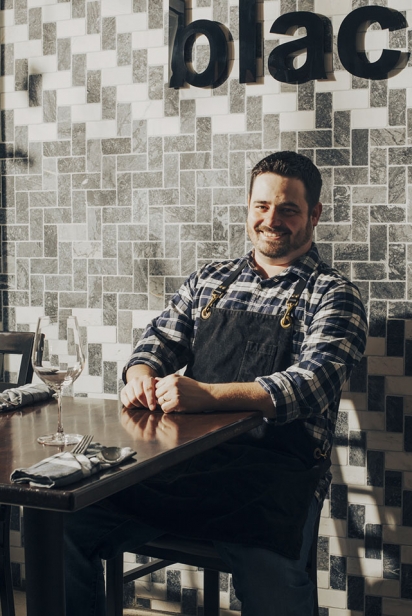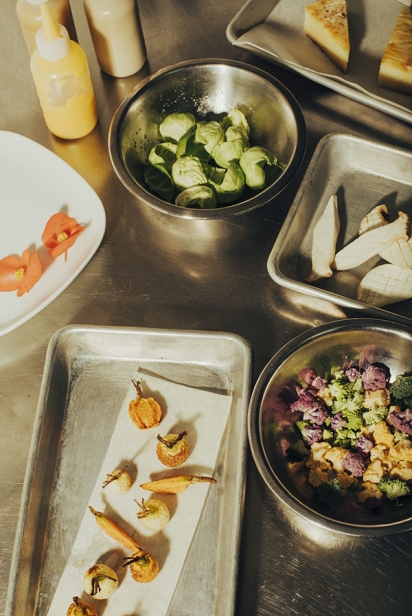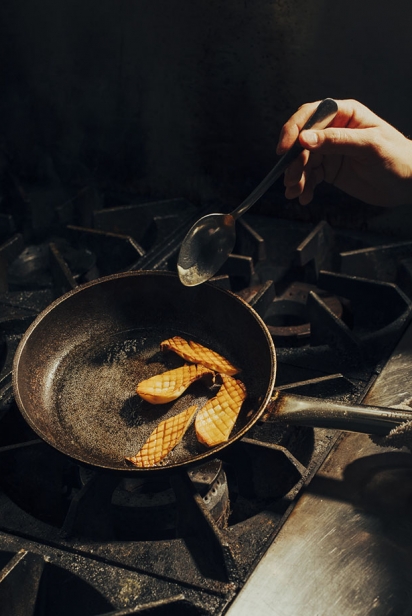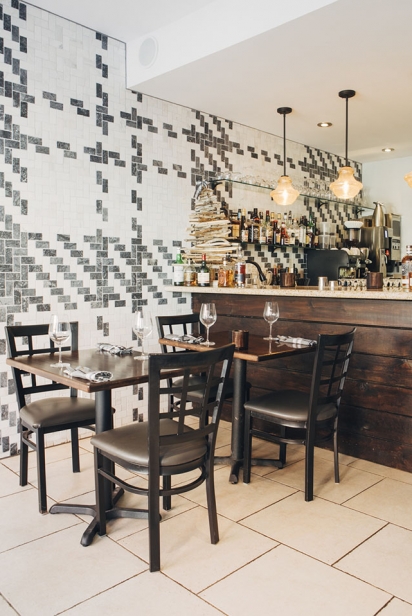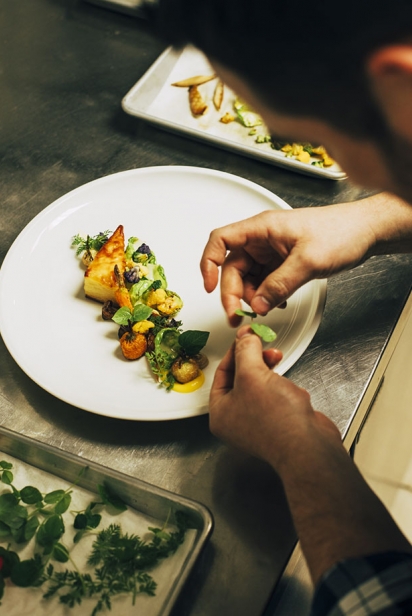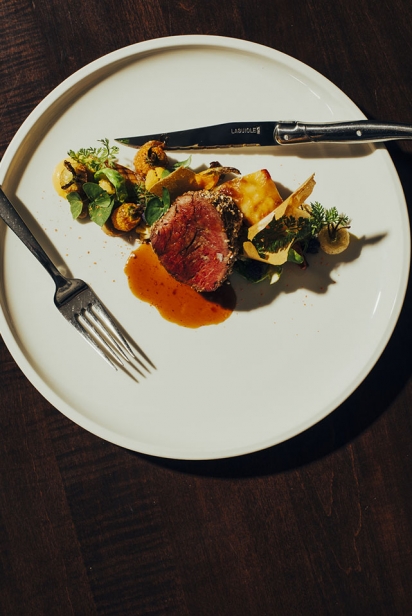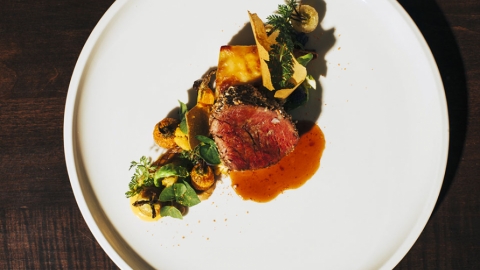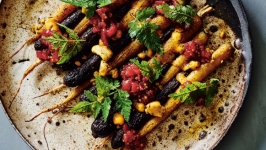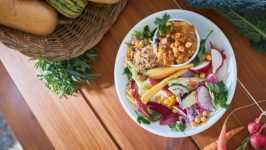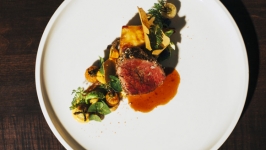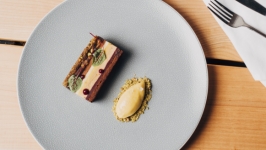The Artful Work of Ian Carswell
Ian Carswell always knew that if he opened his own restaurant, he’d do it in a small town. Four years ago, that’s exactly what he did. Not only has he kept it hopping since then, he’s kept it in the black throughout COVID, in spite of a several-month shutdown at the beginning of the pandemic. Like others, he’s had to pivot, but he’s done it carefully and in a way that respects the community in which he finds his restaurant. Called the Comeback Tour, it turns out it was also a way that has kept his loyal locals coming back.
Asked to produce a plate that spoke to his culinary philosophy and personality, Carswell chose something that also spoke to his small-town roots and his restaurant, Black Tartan Kitchen, in Carleton Place, a town of almost 12,000 people a little more than 50 kilometres west of Ottawa.
The artful plate — full of colour even in the dead of winter — features adorable carrot tops (they’re actually stubby, bulbous carrots he grew at home, their growth stunted from overcrowding); tiny turnips from Nature’s Apprentice in Pakenham; bright green Brussels sprout leaves; yellow, purple and white baby cauliflower; Romanesco broccoli and a big, juicy piece of Little Honey Livestock’s beef tenderloin, seared, then smeared in Dijon and crusted with toasted buckwheat.
He has no problem getting seasonal ingredients, working, as he does, in a town surrounded by farms.
“That’s been the beauty of this restaurant,” he says. “Everything is so easy to do local. Out here, you make different partnerships at the local farmers’ market. It’s almost to the point where it’s difficult to choose who you’re going to work with.”
The plate has other nice touches, including three purées — one earthy mushroom version, one sweet rich caramelized onion and one rutabaga smear across the bottom of the plate. The microgreens come from Burt’s Greenhouses in Odessa and two triangles of scalloped potato sit to one side.
“We slice [the potatoes] super thin and then steep them in cream with butter and herbs to soften them,” he says. “Then we layer them with Gruyère and Emmental cheese, bake and press and finish them in the oven.”
The dish he produced was actually on Black Tartan’s December menu and festively called “The Roast Beast.”
The COVID pivot
Black Tartan Kitchen was open for lunch and dinner when it launched, but after the March 2020 lockdown, Carswell re-opened just Thursday, Friday and Saturday evenings. How, then, to make up the revenue — especially in a restaurant whose capacity at re-opening had dropped from 32 seats to between 10 and 18, the latter on a good day when reservations are for more than two people?
It turns out Carleton Place has an appetite for tasting menus. Carswell launched his new plan with two options: Come in at 5 p.m., enjoy four courses and be home by 7:15 p.m. or, arrive at 7:30 p.m., enjoy seven courses and have the table for the rest of the evening. The four-course meal costs $69 per person and paired wines cost an extra $30 each while the seven-course set is $89 and wine pairings cost $45 per person.
“We’ve been very well received by the community,” he says. The new format has continued that streak.
“Now, we just worry about one menu,” he says. “There’s more variety on each plate and more focus on those plates.”
Many of his customers are locals, but he’s also attracting visitors from Ottawa, particularly as people take mini-breaks closer to home. The Grand Hotel, a boutique operation with just 16 rooms, is just up the street, and many city folks make a weekend of it.
“There’s lots of great places to have breakfast and lunch, too,” says Carswell, who, though he lives in Ottawa with his wife and children, has clearly immersed himself in the Carleton Place community.
A sense of community
As part of that effort, Carswell and his wife, Tessa, bought the building that houses Black Tartan. Carswell makes soups and stews regularly for the food bank when he ends up with a surplus of one ingredient. During the COVID shut down last spring, he used his restaurant to bake bread for the charity. More recently, he has been making lunches to replace the local high school’s lunch program, which had to be put on hold. He also donates a portion of his merchandise sales ($5 for every hat he sells, for example) to the food bank.
“We want to be part of this community and give back to the people who are supporting us,” Carswell says. “The food bank is a great way to do that. They’re right around the corner. That’s been a really good partnership.”
That sense of community weaves its way into the restaurant as well, thanks to its many local purveyors. He often does farm visits, sometimes with his son, 5, and daughter, 7, in tow.
“It’s nice to go out and put some work in,” Carswell says. “Alberto [the farmer at Nature’s Apprentice in Pakenham] loves kids and the kids like to see the chickens.”
They’ve also visited McGahey Farm as a family. A partnership there sees Peter McGahey picking up Black Tartan’s compost for feed for his pigs, which eventually become the restaurant’s charcuterie.
He gets his wild boar and red deer from Trillium Meadows in Vankleek Hill, and Pair A Gardens on Dwyer Hill Road, as well as others, stock his vegetable crispers all summer. Sometimes, Carswell will do elk terrine with product from the ElkRanch in Kanata.
Before COVID, he hosted a monthly “Supper Club” that featured the products of one purveyor — whether a farmer, brewer, winery or cheesemaker. He’d fashion a four-course menu featuring the product and the artisan would speak to diners between every course. It was sold out every month and he expects to bring it back, eventually.
The path to proprietorship
Carswell grew up in Petawawa, having ended up there because his father was raised in a military family.
“I loved growing up there,” Carswell says. “It was probably there that I gained the appreciation for community and also for the farmers around me.”
His mom, the self-proclaimed “hotdog queen,” isn’t a passionate cook, but his father took a keen interest and Carswell followed suit.
“I would procrastinate from school work by baking,” he says. “And then I got a job in a kitchen to pay my way through school. I realized you could learn so much and still never know it all. I like the idea that you’re always learning.”
He studied engineering for a year before going to Nipissing to start a culinary apprenticeship. The sous-chef there was an “encyclopedia of knowledge” — a real Alton Brown type — but he was still always looking to learn more. Carswell loved that.
Before long, he had enrolled in Toronto’s George Brown College’s chef training program. After completing the program, he stayed in Toronto to work at Fare Bistro for chef Brad Clark, who was trained in classic French cuisine.
“That’s where I really fell in love with French food,” Carswell says. “He would always put a spin on the classics. It was intriguing, but it was always so good, the kind of food that hits you in the bones.”
In the summer, they’d pivot to a more Mediterranean menu with lighter fare.
“There, I gained an appreciation for cooking for the seasons,” he says. “I look back on [that time] with such fondness.”
After that, Tessa was heading to Carleton University to study architecture and Carswell came to Ottawa and worked at the now-closed Benitz Bistro for six months and then followed sous- chef Lucas Hornblower, who opened Bistro St-Jacques in Hull. After nine months, he packed up to join Tessa, who was going to Helsinki for the first year of her master’s.
They spent the summer with relatives in Amsterdam and a Michelin-Star chef lived down the street.
“Our relatives set up an interview and I got a job in Brasserie Paardenburg outside of Amsterdam while Tessa worked as an intern architect with a cousin’s firm,” he recalls.
Although Paardenburg didn’t have a star, there was a star within the restaurant group and he got to work there, too.
“That was really cool and put me on the track that cooking can be that next level,” he says. “It gave me an interest in fine restaurants.”
When Tessa headed for Helsinki, Carswell took some time to study wine near Angers, in the Loire Valley, thanks to the same Dutch relatives, who knew the winery owner.
The town had 500 people and no lodging so the winery owners secured him the night porter’s room in a long-term care home, which made for some surreal stories in his three-and-a-half months there.
After that, he went to Helsinki and lucked into a job at a two- Michelin-Star restaurant called Chez Dominique because he happened to show up with a resumé the day a cook had quit. At the time, Chez Dominique was No. 21 in the world according to the World’s 50 Best Restaurants list.
“That gave me a whole new perspective of what you can do with food and how to appreciate different ingredients,” he says. “You can make a dish based on one ingredient, but change the states or the forms. This was when the whole modernist cuisine thing was in full swing in Europe.”
Asked if he ever misses those days where he was learning all the time, he says he now finds inspiration in other places.
“You learn as a mentor, too,” he says. “You get set in your ways so it’s always nice to see a fresh perspective. As long as you keep an open mind, you’re always going to continue to learn.”
Inspiration comes from ingredients
When he and his team are putting together a menu, they usually start with the farmer.
“For the beef dish I made, the farmer approached us to see if we wanted to feature his beef,” he says. “Then you start thinking about what will go with beef — caramelized onions and mushrooms keep it earthy. We can get butternut squash from Limekiln Gardens. We can get mushrooms from Le Coprin and we still have a brown bag of little turnips in the fridge. It’s influenced for sure by what’s available, seasonal and what’s worked well in the past.”
Tessa, while he says she’s “way too smart” to be involved in the restaurant’s day-to-day operations, is instrumental in many ways. She designed the grey, black and white tile wall and the black and white tartan napkins and she produced the art in the restaurant by restoring archival photos and then colour-tinting them. She also came up with all the branding. The restaurant’s name comes from her favourite cocktail, the Black Tartan, which is a potent mix of Johnny Walker Black, Jameson’s, Kahlua and Drambuie all in equal parts. In addition, she looks after all of the communications for the restaurant, including social media.
Tessa’s not the only family involved. Both sets of parents look after the children for the couple, and her dad, a retired brigadier- general, has helped with renovations and also computer challenges. His father has also pitched in on renovations and washes dishes at the restaurant on Friday nights. His mom, meanwhile, does the books.
“I don’t know how you do it without family.”
The comeback tour
Since they were able to re-open in July, the menus have been themed after a comeback tour with lots of greatest hits, complete with cheesy puns on classic song titles. My Corona was a lime- scented palate cleanser made with Corona beer, complete with candied jalapeño chips and a corn-chip rim.
Part five — December’s version of the comeback tour — was a “holiday sendoff,” featuring dishes such as “duck the halls,” “chestnuts roasting on an open fire” and “Yule really enjoy this one.”
As for the first tasting menu for 2021? Once the lockdown lifts, you’ll have to make a visit and find out.
Black Tartan Kitchen
132 Bridge St., Carleton Place, Ont.
blacktartankitchen.com | 613.492.0860 | @blacktartankitchen


